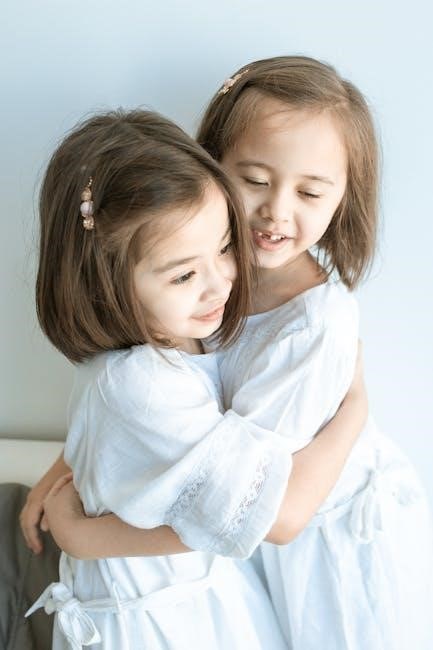
amy tan two kinds pdf
Amy Tan’s “Two Kinds,” part of The Joy Luck Club, explores mother-daughter relationships and cultural identity. It focuses on the immigrant experience and the pressures of the American Dream.
“Two Kinds” centers on Jing-mei Woo and her Chinese immigrant mother, Suyuan. Suyuan, believing in the American Dream’s promise, wants Jing-mei to become a prodigy. She subjects her to various tests, seeking a hidden talent, like Shirley Temple. Frustrated, Jing-mei resists, leading to escalating conflicts.
A disastrous piano recital, a culmination of forced lessons, publicly shames Jing-mei and devastates Suyuan. Jing-mei defiantly declares she wishes she were dead like Suyuan’s lost daughters in China, a deeply hurtful statement. The piano lessons stop, and a chasm forms.
Years later, after Suyuan’s death, Jing-mei is offered the piano. She plays, realizing the two pieces, “Pleading Child” and “Perfectly Contented,” are two halves of the same song. This symbolizes her understanding of her mother, the story ending with reconciliation and acceptance. The story is told from the first-person perspective, allowing a direct connection with Jing-mei’s evolving emotions.

Characters in “Two Kinds”
The story revolves around Jing-mei Woo, the daughter, and Suyuan Woo, her mother. Their complex relationship, filled with conflicting expectations and cultural differences, drives the narrative forward.
Jing-mei Woo
Jing-mei, the American-born daughter, embodies the clash between cultures in “Two Kinds.” Initially, she is willing to participate in her mother’s quest for her to become a prodigy. However, as the pressure mounts, she begins to resist. Jing-mei’s resistance stems from a desire for self-determination and a rejection of her mother’s imposed expectations.
Her rebellious spirit manifests in deliberate acts of defiance, including a disastrous piano recital. This performance becomes a symbol of her failure to meet her mother’s aspirations. Throughout the story, Jing-mei grapples with her identity, torn between her mother’s traditional Chinese values and her own American sense of self. She experiences resentment towards her mother’s unwavering expectations, which ultimately leads to a deeper understanding of their complex relationship. This understanding comes after her mother’s death, revealing the sacrifices and motivations behind her actions.
Suyuan Woo (The Mother)
Suyuan Woo, the mother in “Two Kinds,” is a Chinese immigrant driven by the belief in the American Dream and the boundless potential it offers. Having faced hardship and loss, she is determined to see her daughter achieve greatness. Suyuan’s unwavering belief in Jing-mei’s ability to become a prodigy fuels her relentless efforts to find and cultivate her daughter’s hidden talents.
Her methods, however, are often misguided, leading to conflict with Jing-mei. Suyuan’s expectations are rooted in her cultural background and her desire for her daughter to succeed in a new world. She views America as a land of opportunity where anything is possible, but she struggles to understand her daughter’s resistance to her ambitions. Ultimately, Suyuan’s motivations stem from a deep love for her daughter and a desire for her to have a better life than she had.

Themes in “Two Kinds”
“Two Kinds” explores themes of mother-daughter relationships, cultural identity, the American Dream, and the pressures of expectations. It showcases conflict, disappointment, and eventual understanding.
Mother-Daughter Relationship
At the heart of “Two Kinds” lies the complex and often turbulent relationship between Jing-mei and her mother, Suyuan. Suyuan, a Chinese immigrant, embodies traditional values and a fierce belief in the American Dream, pushing Jing-mei to become a prodigy. This creates a significant clash as Jing-mei, an American-born daughter, resists her mother’s expectations and yearns for self-determination. The story vividly portrays the misunderstandings, resentment, and emotional distance that can arise when cultural differences and personal aspirations collide within a family. The piano becomes a symbol of their conflict, initially representing Suyuan’s imposed dreams and later, a potential bridge towards reconciliation. The narrative explores the sacrifices, unspoken love, and eventual bittersweet understanding that characterize their bond, revealing the enduring power and complexities inherent in mother-daughter relationships.
Cultural Identity
In “Two Kinds,” cultural identity emerges as a central theme, exploring the tension between Suyuan’s traditional Chinese values and Jing-mei’s American upbringing. Suyuan’s belief in limitless potential clashes with Jing-mei’s desire for individuality, highlighting the challenges faced by immigrant families navigating two distinct cultural landscapes. The story delves into the pressure to assimilate while preserving one’s heritage, showcasing the complexities of straddling two worlds. Jing-mei’s rebellion against her mother’s expectations can be interpreted as a struggle to define her own identity within the context of her bicultural experience. The narrative suggests that true identity lies in finding a balance between honoring one’s cultural roots and embracing individual aspirations. Ultimately, “Two Kinds” underscores the importance of understanding and respecting diverse cultural perspectives within the family dynamic.
The American Dream
The American Dream is a prominent theme in “Two Kinds,” representing Suyuan’s aspirations for her daughter, Jing-mei, in a land of opportunity. Suyuan firmly believes that in America, anyone can achieve greatness with determination and effort, driving her to push Jing-mei towards becoming a prodigy. This relentless pursuit reflects the immigrant’s hope for a better future for their children, fueled by the promise of upward mobility and success. However, the story also critiques the potential pitfalls of blindly chasing the American Dream, highlighting the pressure and expectations it places on individuals, particularly children of immigrants. Jing-mei’s resistance to her mother’s ambitions underscores the conflict between pursuing external success and defining one’s own path to happiness. The narrative suggests that the true meaning of the American Dream lies not in achieving societal expectations but in finding personal fulfillment and self-discovery.
Expectations and Disappointment
Expectations and disappointment are central to the conflict in “Two Kinds,” driving the wedge between Jing-mei and her mother, Suyuan. Suyuan’s high expectations for Jing-mei to become a prodigy, fueled by her belief in the American Dream, create immense pressure on her daughter. Jing-mei, unable to meet these unrealistic expectations, experiences feelings of inadequacy and disappointment, leading her to rebel against her mother’s ambitions. The disastrous piano recital serves as a pivotal moment, solidifying the disappointment and resentment between them. This event highlights the damaging effects of imposing parental expectations on children, particularly when they clash with individual desires and abilities. The story underscores the importance of accepting and appreciating individuals for who they are, rather than forcing them to conform to preconceived notions of success. Ultimately, “Two Kinds” suggests that true acceptance and understanding can only emerge when expectations are tempered with compassion and empathy.

Literary Analysis of “Two Kinds”
Amy Tan employs rich literary devices in “Two Kinds” to explore its themes. Narrative structure, point of view, and powerful symbolism, like the piano, deepen our understanding of the characters and their complex relationship.
Narrative Structure and Point of View
“Two Kinds” employs a compelling narrative structure, unfolding in a nonlinear fashion. The story shifts between the narrator’s present-day reflections and her childhood experiences, roughly twenty-five years prior. This structure allows Amy Tan to juxtapose Jing-mei’s adult understanding with the raw emotions of her youth. The narrative is constrained to these two timelines, though the narrator shares facts about other times.
The story is told from Jing-mei’s first-person point of view, providing an intimate and subjective perspective. This allows the reader to experience the events through her eyes, understanding her feelings of resentment, rebellion, and eventual understanding. However, it also limits the reader’s access to the mother’s perspective, leaving room for interpretation and prompting consideration of her motivations. The first-person narration shapes our understanding of the complex mother-daughter dynamic.
Symbolism (The Piano)
The piano in “Two Kinds” serves as a potent symbol, embodying multiple layers of meaning. Initially, it represents the mother’s aspirations for Jing-mei to become a prodigy, a symbol of the American Dream and the limitless potential she believes her daughter possesses. It becomes an instrument of conflict, a battleground where Jing-mei’s resistance clashes with her mother’s expectations.
However, the piano’s symbolism evolves throughout the story. After Jing-mei’s disastrous performance and subsequent refusal to play, it becomes a symbol of broken dreams and unresolved conflict. Yet, after her mother’s death, Jing-mei’s rediscovery of the piano and the two pieces, “Pleading Child” and “Perfectly Contented,” suggests a potential for reconciliation and understanding. The piano, in the end, represents both the discord and the possibility of harmony within their complex relationship.

Critical Perspectives on “Two Kinds”
“Two Kinds” invites diverse critical lenses: feminist, reader-response, psychoanalytic, and postcolonial. These perspectives offer deeper insights into its themes of identity, family dynamics, and cultural conflict within the narrative.
Feminist Perspective
A feminist reading of “Two Kinds” examines gender roles and power dynamics. The mother-daughter dynamic reflects societal expectations placed on women, particularly within immigrant communities. We see an analysis of Jing-mei’s struggle for self-determination as resistance against patriarchal norms, specifically the pressure to conform to her mother’s vision of success. The story explores the limitations imposed on women and their fight for agency; The power dynamic in the family is unbalanced.
The story critiques societal pressures that force women to fulfill specific roles. Jing-mei’s rebellion represents a rejection of these constricting expectations. The narrative explores the complexities of female identity. It highlights the challenges women face in pursuing their own aspirations. The story explores themes of female empowerment.
Reader-Response Perspective
A reader-response approach emphasizes the reader’s active role in constructing meaning from “Two Kinds.” Individual interpretations of the mother’s motivations vary. Readers may relate to themes of familial pressure based on personal experiences. The open-ended conclusion leads to differing interpretations, shaping the story’s impact. Readers connect with Jing-mei’s rebellion.
The readers’ background influences their understanding of the cultural clash. Personal values affect their judgment of the characters’ actions. The interpretation changes based on the reader’s own experiences with parental expectations and cultural identity. Readers may sympathize with the mother or daughter. This depends on their individual experiences and beliefs. The story’s power comes from the diverse range of reader interpretations.
Psychoanalytic Perspective
A psychoanalytic lens explores unconscious desires, repressed memories, and motivations in “Two Kinds.” The mother’s fixation on Jing-mei’s success could stem from her own unfulfilled dreams and past traumas. This can manifest as a projection of her own needs onto her daughter. Jing-mei’s rebelliousness is viewed as a subconscious response to control and suppressed individuality. Her actions are driven by a desire to assert her own identity.
The story could be seen as a representation of the Oedipal complex. Jing-mei struggles to separate from her mother and establish her own self. Unconscious desires and conflicts shape the characters’ interactions. The piano is a symbol of their unresolved issues. It represents both connection and conflict. The ending offers a potential for healing. This can happen through understanding and acceptance.
Postcolonial Perspective
A postcolonial reading of “Two Kinds” examines the impact of cultural displacement and assimilation. The mother’s aspirations are viewed through the lens of the immigrant experience. She seeks to secure her daughter’s success in a new land. The story critiques the American Dream, highlighting the pressures faced by immigrant families. Jing-mei’s struggle reflects the tension between embracing American individualism and preserving her cultural heritage.
The narrative explores the complexities of identity formation in a postcolonial context. Jing-mei grapples with her bicultural identity. She must navigate the expectations of her mother’s traditional Chinese values and the dominant American culture. The story critiques the notion of assimilation, emphasizing the importance of cultural heritage. It validates the individual’s right to self-determination. “Two Kinds” offers a nuanced perspective on the immigrant experience. It showcases the challenges and triumphs of navigating multiple cultural identities.